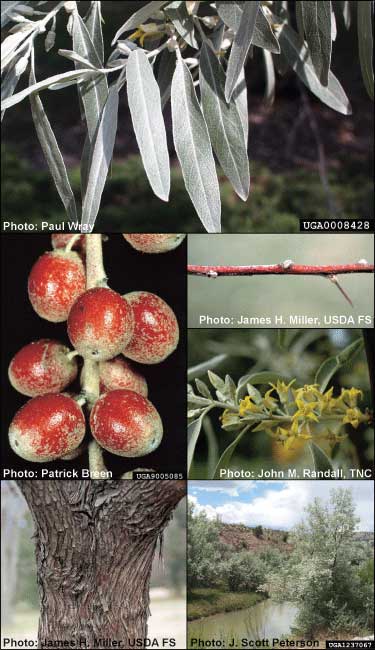Russian olive (Elaeagnus angustifolia)
 Synonyms: Elaeagnus angustifolia L. var. orientalis
Synonyms: Elaeagnus angustifolia L. var. orientalisCommon Names: Oleaster
Description: Forms a dense, monospecific shrub layer displacing native species and closing open areas; alters nutrient cycling and hydrology.
Habit: Deciduous thorny shrub or small tree growing up to 9 m (30 feet) in height; rounded in shape with a loose arrangement of branches.
Leaves: Simple, alternate, oblong, 4-8 cm (1.5-3 in) long, untoothed margins; light green and covered with silvery star-shaped hairs above, silvery white and densely covered with scales below.
Stems: Slightly thorny on ends; silvery scales present when young; bark is thin and comes off in elongated strips.
Flowers: Small, highly aromatic, yellowish in color, silver inside, umbel-shaped, single or clustered, blooms shortly after leaf emergence; blooms June through July.
Fruit and seeds: Hard, yellow-red, olive-shaped fruits, 1 cm (0.4 in) long with silvery scales, clustered along stems in great quantities, eaten and dispersed by many bird species; begin fruiting at 3 to 5 years.
Habitat: Relatively shade tolerant; invades open and disturbed areas; can occur in a variety of soil and moisture conditions; not tolerant of acidic conditions (pH<6.0).
Reproduction: Primarily by seed, also vegetatively or by root sucker at the root crown.
Similar species: Non-native autumn olive (Elaeagnus umbellata) has shorter, broader, slightly less silvery leaves; closely related native rabbit-berry and buffalo-berry (Shepherdia spp.) have opposite leaves, usually smaller; sage willow (Salix candida) has serrate leaves.
Monitoring and rapid response: Monitor edge habitats, particularly along streams and rivers; early detection is critical as large stands are almost impossible to eradicate. Hand pull seedlings; small seedlings susceptible to fire. Burning, mowing, cutting and girdling all stimulate resprouting in larger plants without herbicide treatment; treat cut stumps with an herbicide; basal bark treatment effective on young trees; foliar herbicide treatment effective for small trees, resprouts. Credits: The Michigan Natural Features Inventory (MNFI) has partnered with MISIN to provide the information in this fact sheet. Species images and/or information were used with permission from "A Field Identification Guide to Invasive Plants in Michigan's Natural Communities" and "A Field Guide to Invasive Plants of Aquatic and Wetland Habitats for Michigan.
Common Name: | Russian olive |
Scientific Name: | Elaeagnus angustifolia |
Family: | Elaeagnaceae (Oleaster) |
Duration: | Perennial |
Habit: | Shrubs |
USDA Symbol: | ELAN |
 View Species Course |
|
